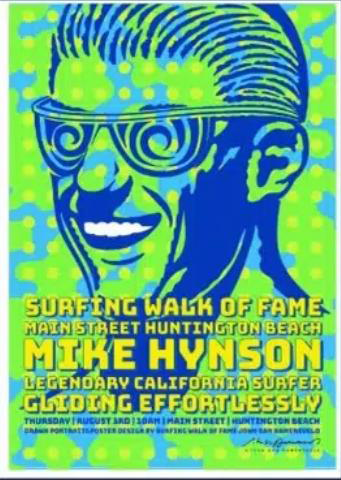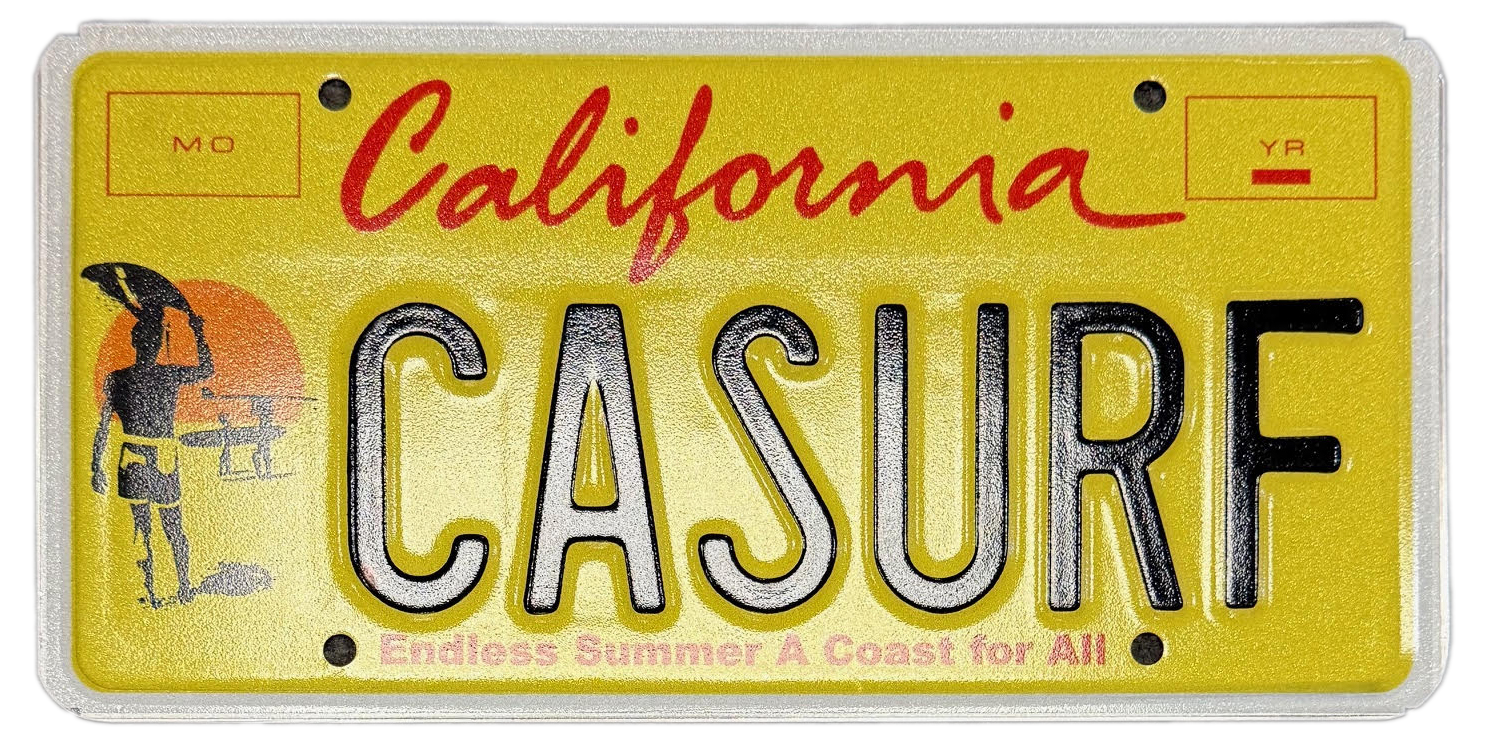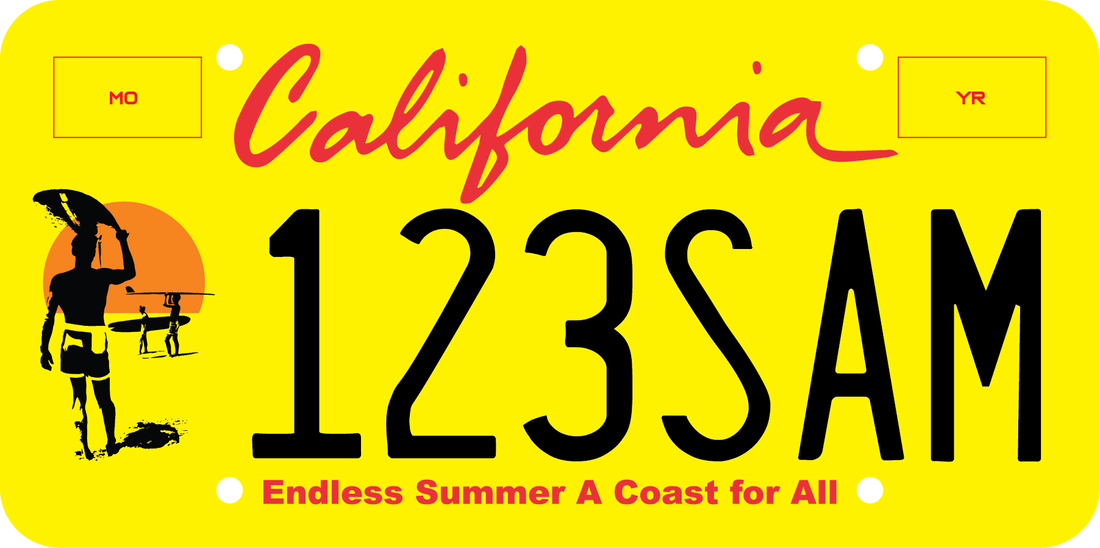|
California drivers can now take a piece of surf history on the road while championing coastal preservation. After nearly a decade in the making, the iconic Endless Summer license plates are finally here, blending a celebration of California’s surfing culture with a mission to protect our cherished coastline. The last step is to complete the required 7,500 presale. CLICK HERE TO ORDER NOW. In collaboration with California Coastal Conservancy, Bruce Brown Films, LLC has unveiled these stunning, specially designed plates inspired by the legendary 1964 Endless Summer poster. Featuring surfers silhouetted against a radiant sunset, this vibrant design is more than just a tribute to Bruce Brown's groundbreaking film—it’s a pledge to preserve California’s coastal beauty for generations to come.
Help get the Endless Summer plate on California roads, pre-order your Endless Summer plate today at surfPlate.com and help make waves for a better tomorrow.
0 Comments
grant from california coastal conservancy helps save iconic surfers' point in ventura county4/25/2025 In 1992, the City of Ventura, California, saw the return of a familiar problem: the recently re-constructed bike path along the beach at Surfers' Point was eroding away again. Coastal erosion eventually swallowed large portions of the bike path, as well as the parking lot at the adjacent fairgrounds. Hasty efforts to preserve the area ultimately led to further damage. By 1997, crumbling asphalt, concrete barricades, and rusty chain-link fences erected to keep people from danger made the area a hazardous eyesore. In 1995, a working group that included city planners, the California Coastal Conservancy, the State Coastal Commission, the Ventura County Fairgrounds, the Surfrider Foundation, and other stakeholders began to consider and propose options for restoring the beach. Paul Jenkin, Ventura Campaign Coordinator of the Surfrider Foundation, worked to engage residents, making numerous public presentations and encouraging groups to work toward a win-win solution. The effort, ultimately called the Surfers' Point Managed Shoreline Retreat Project, was beset by conflicting ideas about the best strategy for addressing the problem, pressure to keep the area open for public recreation, and the challenges of reaching a compromise and securing funding. In 2011, the Surfers' Point working group celebrated the completion of the first phase of the project. Using grant funds from the California Coastal Conservancy and the Federal Highway Administration, the project successfully relocated the bike path and beach parking lot out of harm's way. To stabilize the area, the project constructed a "cobble mattress" on the back beach, replacing artificial fill that had been imported for the parking lot. Sand from inland sources was placed in the retreat zone to complement the cobbles and help re-create dunes. Later, the project constructed dunes using sand from downcoast beaches where onshore winds were creating a problem of excess sand. As of 2014, the beach at Surfers' Point has a 70-foot wide buffer zone and a significant sediment reservoir. As a result of increased dune elevations, erosion is no longer a threat to infrastructure inland from the beach. The project was designed with sea level rise in mind, and project leaders feel confident the restored area will prove to be more resilient than adjacent beaches as water levels increase. Though the situation has improved, rising sea levels will continue to threaten the beach. The local Surfrider group will likely remain active, working to protect the beach by ensuring its resilience. For full story, click here
Join the Coastal Conservancy March 17 from 12:00-1:00 for a webinar about funding opportunities from the 2024 Climate Bond (Prop 4). Conservancy staff will provide an overview of our Climate Bond funding, our priorities, and how to apply for Conservancy grants. There will also be time for Q & A. A recording of the webinar will be posted on our website subsequently.
The webinar will be held via Microsoft Teams. Join the meeting at 12:00 on 3/17 Meeting ID: 246 363 206 375 Passcode: KM3VW2zo For the first time, the U.S. Army Corps of Engineers will study impacts of sea level rise on the entire region with focus on economically disadvantaged communities, vulnerable infrastructure, and nature-based strategies. The State Coastal Conservancy, Save The Bay, the Bay Conservation and Development Commission, the Bay Area Council, the San Francisco Bay Joint Venture, the Bay Planning Coalition, the Bay Area Regional Collaborative (BARC), San Mateo County Flood and Sea Level Rise Resiliency District (also known as OneShoreline), and the California Natural Resources Agency announce that the Thomas R. Carper Water Resources Development Act of 2024 (WRDA), signed today by President Biden, now includes a section instructing the U.S. Army Corps of Engineers (USACE) to conduct a study of measures to adapt to rising sea levels in the San Francisco Bay Area. The study, which is anticipated to begin in 2026, assuming funding, builds on and expands USACE’s existing authority to address the impacts and adaptation to sea level rise and climate change in the 9-county Bay Area’s ocean and bay shorelines. In addition to investigating measures to adapt to rising sea levels, the USACE study will consider the needs of economically disadvantaged communities and the existing vulnerable infrastructure of these areas, and the use of natural features and beneficial use of dredged sediment in the solutions. WRDA also directs USACE to look at the effects of proposed flood or shoreline protection, coastal storm risk reduction, environmental infrastructure and other measures on the local economy, recreation, aquatic ecosystem restoration, public infrastructure protection, and stormwater runoff capacity, as well as the erosion of beaches and coasts. “The San Francisco Bay Area is no stranger to the harmful effects of climate change, including extreme heat, prolonged droughts, and rising sea levels. Thanks to the Thomas R. Carper Water Resources Development Act of 2024 (WRDA), which I supported and voted in favor of, the U.S. Army Corps of Engineers will be able to partner with local agencies to study how to mitigate sea level rise and curb its effects on nearby communities. I remain committed to advancing efforts that improve resiliency, expand our water supply, and protect our environment,” said Rep. Zoe Lofgren (CA-18). “Bay Area leaders have worked hard to understand the impacts of sea level rise to this region,” said California Natural Resources Secretary Wade Crowfoot. “We know that climate change has worsened flooding and storm surge risks, with real threats to local communities. Now, thanks to this federal action, experts at the Army Corps of Engineering will help us better understand these risks and how we can best prepare and protect local residents. This is a big step forward that will help the Bay Area continue to thrive into the future.” Regional funding through Measure AA, State of California funding through the 2024 Climate Bond, and stakeholder contributions will leverage federal funding through USACE for the regional study and future projects. The San Francisco Bay Area stands to be one of the hardest hit regions in the nation from rising sea level, with over 8 million residents, 9 counties, 101 cities, and vital infrastructure, communities, ecosystems, and businesses—all clustered around a single bay. The impacts to communities along San Francisco’s 400-mile shoreline are expected to land disproportionately on socially vulnerable populations, which are the most at risk and least able to recover from flooding. With the projected sea level rise under state guidance of +0.8 feet by 2050, the Bay Area must prepare now to effectively manage the risks to human health and safety and the estimated hundreds of billions of dollars in losses to property and infrastructure. Specific assets at near-term risk include airports, ports, wastewater treatment plants, major highways and roadways, public transit and thousands of homes in low and moderate-income communities. “The inclusion of this language in WRDA really lets the Army Corps think on the landscape scale about sea level rise resilience for the region and opens the doors for flood and conservation agencies working in the Bay to partner with USACE across a number of projects.” said Amy Hutzel, Executive Officer of the State Coastal Conservancy. “The Corps brings the expertise and resources needed to tackle some of the region’s largest and most challenging restoration and flood protection projects. We see them as an essential long-term partner to meeting our resilience goals and I’m excited to see the project opportunities this study will lead to.” “The Water Resources Development Act recently signed into law by President Biden allows the U.S. Army Corps of Engineers to conduct a comprehensive sea level rise analysis for the entire Bay Area shoreline, a critical step to defending the region’s residents and innovation economy for the next century and beyond.” said Jim Wunderman, President & CEO of the Bay Area Council. “Special thanks to Congressman Khanna, Congressman Garamendi, Congressman Huffman, Congresswoman Lofgren, and Congressman Mullin for delivering this win for the entire region.” “San Francisco Bay is home to some of the most vibrant and vital wildlife habitat on the West Coast, all within a dense urban population. This study will help us better understand how habitat restoration and nature-based solutions can increase resilience to sea level rise for people and nature.” said Rebecca Schwartz Lesberg, Chair of the San Francisco Bay Joint Venture’s Management Board. “Sea level rise flooding is a regional challenge because floodwaters don’t stop at city borders,” said David Lewis, Executive Director of Save The Bay. “The Army Corps’ new study will identify regional opportunities to invest in impactful nature-based resilience projects like additional tidal marsh restoration. Building these projects now is critical to ensuring a healthy Bay shoreline that protects our communities from rising tides.” “I am ecstatic that the Congress and President Biden are supporting a federal study on the impacts of rising sea levels on the San Francisco Bay,” said Larry Goldzband, Executive Director of the San Francisco Bay Conservation and Development Commission. “Protecting our vulnerable communities and natural habitat in the Bay from rising sea levels is going to cost an estimated $110 billion by 2050. We cannot achieve that without federal partnership.” “This study will build upon existing science, prioritizing the Bay’s economically disadvantaged and climate-vulnerable communities to identify where the impacts of sea level rise will hit the hardest. We are excited to collaborate with the Army Corps to protect these areas while maximizing the use of nature based solutions to support the bay’s wildlife habitats.” said Allison Brooks, Executive Director, Bay Area Regional Collaborative (BARC). “The task of planning and building long-term climate resilience along the Bay shoreline will largely fall to local governments, and having the federal government as a partner through that process will be extremely helpful. We look forward to working with USACE and the other eight counties along the Bay to align protection to the inter-related threats of sea level rise and extreme storms.” said Len Materman, Chief Executive Officer, San Mateo County Flood and Sea Level Rise Resiliency District.
Since 2013, the Conservancy has awarded over $18.2 million in 296 separate Explore the Coast grants and brought over 185,000 people on field trips to the coast (updated October 2022). ETC grants fund a wide range of programs that bring people to the coast or to the shores of San Francisco Bay. At least 70% of participants served by the ETC grant must be from an ETC Priority Community. In addition to meeting this requirement, projects must also meet the following program priorities:
Examples of ETC Grantees: The Amah Mutsun Land Trust’s Summer Camp provides Native American youth meaningful and fun experiences to enjoy their coastal ancestral territory on the San Mateo and Santa Cruz coast while learning about coastal conservation and traditional ecological knowledge. Participants experience hands-on cultural learning and coastal, recreational activities that promote appreciation and connection their cultural identities. Brown Girl Surf’s Surf Sister Program offers surfing lessons, history, and ocean education for women and girls who identify as Black, Indigenous, or people of color primarily from Alameda and other Bay Area Counties. The program builds a welcoming community of “surf sisters” who support each other to surf and safely enjoy the ocean. In San Diego, Outdoor Outreach’s Coastal Adventure Club Program creates coastal outings for disadvantaged youth to go kayaking, paddle boarding, surfing, biking, hiking, and tide-pooling. This program also offers a pathway to job and leadership opportunities where participants can go on to become instructors and peer mentors for other youth in the program. Environmental Traveling Companions offers life-changing sea kayaking, whitewater rafting, and cross-country skiing, and youth leadership adventures to more than 100,000 people with special needs, including people with visual or mobility impairments, developmental disabilities, cancer and other life-threatening illness, and youth from economically disadvantaged backgrounds. Environmental Traveling Companions has received Explore the Coast grants to facilitate sea kayaking adventures in Richardson and Tomales Bay in the San Francisco Bay Area.
For any questions about the Explore the Coast grant program, please email [email protected]. Programs that teach Californian’s to value the state’s coastal resources or programs that combine education with beach maintenance and habitat restoration projects should also consider applying for a Coastal Commission Whale Tail Grants.  Now in its third incarnation, A Great Day in the Stoke, the largest gathering of Black surfers on the planet, returned to the Huntington Beach Pier on Saturday, September 14. The brainchild of Nathan Fluellen, the event first got underway in 2022 as a way to bring Black and African American surfing communities together. Today, it’s turned into a full movement that attracts hundreds of surfers and offers so much more than just a another surf contest. Created in the aftermath of the murders of George Floyd, Ahmaud Arbery, and Breonna Taylor, along with other race-based issues, A Great Day in the Stoke was intended to get people together and bring something positive to the beach. Inspired by A Great Day in Harlem in 1958 and a Great Day in Hip Hop in 1998, the initial running of A Great Day in Stoke saw over 500 people show up. A little bit surf contest, a little bit beach party, as well as part health and wellness festival and community gathering, there really was something for everybody going down at A Great Day in the Stoke. On the surf side, there were events for shortboard, longboard and groms.
Hawaii’s Julian Williams was on hand to successfully defend his shortboard title, and won the longboard title. Sahara Faye won the women's longboard, edging out last year's winner, Farmata Dia and Monik Santos won the shortboard. Logan Moss won the boys grom. There were free surf lessons for anyone looking to dip a toe in the water for the first time, beach yoga and a double dutch competition. For more information: click here For almost a century, the automobile has been much more than a mere mode of transportation, but rather an extension of its owner's personality with its style and panache. The auto makers sought to capitalize on America's thirst for style and power in providing sleek and faster cars which pandered to the public's desire to have their car reflect their own self image. Ever changing designs, brighter colors and engine size contributed to the symbolic nature of the automobile for its owner. As an extension of the goal of making your car an extension of your personality or self-image is the specialty license plate. Usually connected to a charity or state agency, the specialty license plate provides the quintessential "win win" dynamic in that the vehicle owner can both help a legitimately good cause and own a license plate make a social statement to those who see it, or maybe just look cool with its colors and design. In California, a new specialty plate has been approved which boldly touches all of those bases. It is the Endless Summer specialty license plate, which incorporates the theme from Bruce Brown's iconic Endless Summer movie from the 1960's. The exquisite design of the plate, with its bright yellow background and setting sun, evokes imagery of California's pristine beaches, beautiful sunny days and sport of surfing and embraces the California state of mind. Because funds from the sale of this specialty license plate help fund California's Coastal Conservancy, which promotes and protects the public's access to California's beaches, anyone who purchases the plate not only gets to display the beautiful and radiant plate on their car, but also promotes the many goals of that wonderful state agency. The legacy of Endless Summer is that it is more than a movie of youth, oceans and the pursuit of the perfect wave. It is symbolic of an optimistic state of mind reflecting sunny days, summer breezes and beautiful vistas. You can help preserve California's coast and project a sunny and optimistic statement for your car or motorcycle. For more information as to how you can register for the presale, click here. The proposed Endless Summer license plate has been awaiting final visibility testing by CHP for over 3 months.
California Code of Regulations, 13 CACode of Regs, 160.04, requires: (4) The design must meet the following standards after testing by the Department of California Highway Patrol (CHP): (A) The registration number must be clear and legible to a person with 20/20 vision in daylight from a distance of 75 feet, and in darkness with low-beam headlamps from 75 feet; and (B) The registration number must be able to be accurately perceived by Automated License Plate Reader technology in use in California from a distance of 35 feet at daytime, dusk and nighttime.  In 1966, footage of Mike Hynson walking atop his longboard debuted in theaters across the world. Alongside Robert August and filmmaker Bruce Brown, Hynson’s globe-trotting in 'The Endless Summer' helped establish a precedent of surf exploration that has lasted nearly 60 years later. The San Diego surfer and shaper enjoyed a different kind of trek when he became inducted into Huntington Beach’s Surfing Walk of Fame, along with Surf Pioneer Bing Copeland, Surfing Champion Felipe Pomar, Local Hero Jeff Deffenbaugh, Surf Culture Doug Warbrick & Brian Singer (Rip Curl Founders), and Woman of the Year Sally Fitzgibbons. To commemorate the induction, John van Hamersveld, who designed 'The Endless Summer' poster, was commissioned to produce a work of art. The California State Coastal Conservancy announced more than $39 million in funding for projects to improve public access, climate resilience, habitat values, and inclusion at the coast.
“The Coastal Conservancy’s vision is of a beautiful, restored, and accessible coast for current and future Californians. To achieve this, we fund projects that support the coast’s natural resources, projects that prepare the coast for the challenges of a changing climate, and projects that help more people enjoy the coast.” said Amy Hutzel, Executive Officer of the Coastal Conservancy. Among the awards were several projects that will expand the Californians’ ability to access and enjoy the coast: $1,104,736 was awarded to eight non-profit organizations for Coastal Stories projects that will create storytelling installations, murals, or interpretive materials that represent diverse communities’ perspectives that historically have been excluded from narratives of California’s coast and publicly accessible lands. This is the second round of funding through the Conservancy’s Coastal Stories grant program. The Big Sur Land Trust was awarded $2,750,000 to acquire the 84-acre Hiss Parcelin the City of Monterey for natural resource conservation, California Native American tribal cultural resource conservation, habitat connectivity, California Native American tribal access, and public access. Orange County Coastkeeper was awarded $250,000 for the Beach and Coast Accessibility Program to provide grants to nonprofits, public entities, and tribes for beach wheelchairs and other equipment to increase accessibility to California’s beaches and coast in coastal counties statewide. Sustainable Conservation was awarded $270,300 to augment the Conservancy’s existing grant of $620,000 to advance adoption of, and conduct outreach to facilitate the use of, programmatic permits for aquatic habitat restoration and water quality improvement projects. Defenders of Wildlife and Sea Otter Savvy were awarded $174,400 to implement two separate projects to aid in the recovery of the southern sea otter. FOR MORE INFORMATION on the awarded projects CLICK HERE. Coastal Conservancy has announced the availability of grants to public agencies, federally recognized tribes and California Native American communities, and nonprofit organizations for programs that facilitate and enhance the public’s opportunities to explore California’s spectacular coast and San Francisco Bay shoreline through Coastal Conservancy's Explore the Coast Grant Program.
Applicants may request a grant amount of up to $100,000. Approximately $800,000 is available for this grant round. Approximately $134,000 of the $800,000 is available for participants to go to the San Francisco Bay shoreline. The remaining $666,000 must be used to bring participants to the outer coast. The application deadline is January 31, 2024 by 11.59pm. Applicants should apply for projects that aim to start in late 2024 or early 2025 and aim to be completed by December 2027. The Conservancy will base the size of the award on each project’s needs, its overall benefits, and the extent of competing demands for funds. More information on the RFP and how to apply can be found here. |
blogArchives
May 2025
Categories
All
|
Funding from this plate will be directed to programs that promote coastal access, make coastal lands welcoming to all, and increase opportunities for coastal enjoyment.





